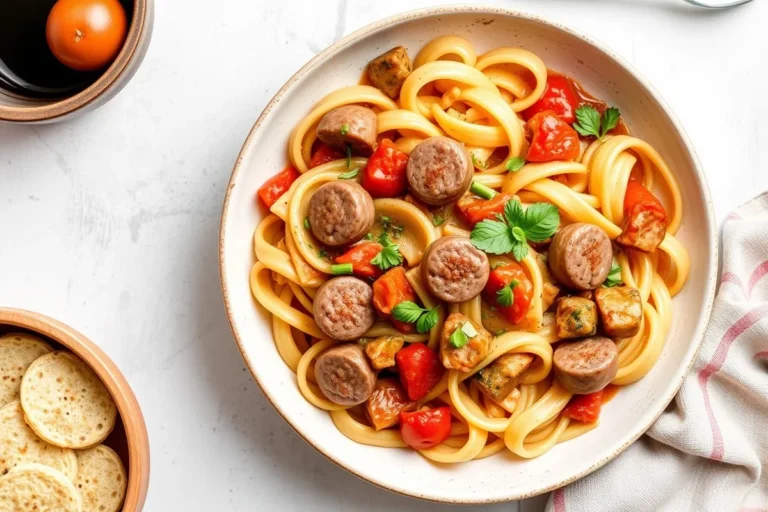What is Pastalaya?
Pastalaya is a delectable Cajun dish that combines the bold, smoky flavors of jambalaya with the comforting heartiness of pasta. Rooted in Louisiana’s rich culinary heritage, this dish reimagines traditional jambalaya by replacing rice with pasta, creating a unique twist that’s both innovative and irresistible.
This flavorful fusion retains the spicy, savory essence of classic jambalaya, enhanced by the tender, satisfying texture of pasta. The result is a one-pot wonder that’s easy to prepare and packed with bold, crowd-pleasing flavors.
Perfect for festive gatherings, potlucks, or family dinners, Pastalaya embodies the spirit of Cajun cuisine: hearty, flavorful, and versatile. The dish can be customized with a variety of proteins, including chicken, sausage, or seafood, making it suitable for diverse tastes. Its adaptability and ease of preparation have made it a staple in homes and celebrations alike.
Whether you’re craving something new or looking for a comforting dish with a rich cultural history, Pastalaya is a must-try recipe that guarantees to delight any palate.
History of Pastalaya
The story of Pastalaya is deeply rooted in Cajun culture, which itself is a melting pot of French, African, and Spanish influences. Jambalaya, the dish that inspired Pastalaya, has been a cornerstone of Cajun and Creole cuisine for centuries.
As the story goes, Pastalaya was created as a more affordable or innovative alternative to jambalaya. By replacing rice with pasta, cooks could stretch their ingredients further, feeding large gatherings without compromising on flavor.
Over time, this adaptation gained popularity, especially during Cajun gatherings like festivals and family reunions, where large quantities of food are essential.
Today, Pastalaya is celebrated as a modern twist on a classic dish, demonstrating the Cajun spirit of improvisation and creativity.
Key Ingredients for Authentic Pastalaya
Creating an authentic Pastalaya starts with high-quality ingredients. Here’s what you’ll need:
- Pasta: Traditionally, linguine or spaghetti is used, though penne or fettuccine are also popular.
- Meats: Smoked sausage (such as andouille), chicken, or even seafood are common proteins.
- Vegetables: The “Holy Trinity” of Cajun cooking—onion, celery, and bell pepper—forms the flavor base.
- Broth: A rich chicken or seafood stock to infuse the pasta with savory goodness.
- Seasonings: Cajun spices like paprika, garlic powder, cayenne, and thyme bring the dish to life.
- Tomatoes: Some variations include diced tomatoes for extra flavor and moisture.
These ingredients form the backbone of Pastalaya’s bold and hearty profile.
Pasta vs. Rice: The Unique Twist
One of the defining features of Pastalaya is its use of pasta instead of rice. This substitution gives the dish a distinct texture and makes it easier to prepare for those who may not be comfortable cooking rice.
- Texture: Pasta absorbs the rich flavors of the broth and spices while maintaining a firm yet tender bite.
- Cooking Time: Pasta generally cooks faster than rice, making Pastalaya a quicker alternative to jambalaya.
By swapping rice for pasta, this dish introduces a delightful variation on a classic while remaining true to its Cajun roots.
Types of Pastalaya Recipe
Pastalaya is incredibly versatile, with variations to suit any palate:
- Chicken Pastalaya: A hearty version featuring tender chicken as the primary protein.
- Seafood Pastalaya: A luxurious twist incorporating shrimp, crawfish, or crab.
- Sausage Pastalaya: Smoked sausage like andouille gives a smoky, spicy kick.
- Vegetarian Pastalaya: Loaded with vegetables and plant-based proteins for a lighter option.
Each variation adds its unique flair to the dish, ensuring there’s a Pastalaya for everyone.
Essential Cooking Equipment for Pastalaya
Cooking Pastalaya doesn’t require a lot of fancy equipment, but a few key tools will make the process easier and more enjoyable:
- Large Pot or Dutch Oven: A heavy-bottomed pot is essential for even cooking.
- Wooden Spoon: Perfect for stirring and ensuring ingredients don’t stick.
- Knife and Cutting Board: To chop the vegetables and prepare the meat.
- Colander: For draining pasta, if cooked separately.
Cast Iron Pots for Cooking Pastalaya Recipe
Cajun tradition often calls for the use of cast iron pots when preparing Pastalaya. These pots offer several advantages:
- Heat Retention: Ensures even cooking and prevents burning.
- Flavor Enhancement: Over time, cast iron develops a seasoning that enhances the dish’s flavor.
- Durability: Cast iron can withstand high heat and is perfect for outdoor cooking at large gatherings.
Investing in a good cast iron pot will elevate your Pastalaya cooking experience.
Why Choose Pastalaya Recipe Over Jambalaya?
While both dishes are beloved staples of Cajun cuisine, Pastalaya has its own unique appeal:
- Ease of Preparation: Pasta cooks faster and is more forgiving than rice.
- Variety: The choice of pasta types adds versatility.
- Flavor Absorption: Pasta soaks up the flavors of the broth and spices, creating a deeply satisfying taste.
If you’re looking for a dish that’s both traditional and innovative, Pastalaya is the perfect choice.
Nutrition Facts of Pastalaya
The nutritional value of Pastalaya can vary depending on the ingredients, but here’s a general breakdown for one serving (approximately one cup):
- Calories: ~350-450
- Protein: 15-20g (from meats and pasta)
- Carbohydrates: 30-40g
- Fat: 10-15g (depending on the type of meat and oil used)
While it’s not the lightest dish, you can adjust the recipe to make it healthier, such as by using whole-grain pasta or lean proteins.
Part 3: Tips, Variations, and Cultural Context
Creative Variations of Pastalaya
One of the reasons Pastalaya has become a staple in Cajun cuisine is its versatility. By tweaking the ingredients or cooking method, you can create a dish tailored to your tastes or dietary needs.
1. Spicy Pastalaya
- Add fresh or dried chili peppers, like jalapeños or habaneros, to the Holy Trinity for an extra kick.
- Use hot sausage varieties like spicy andouille or chorizo.
- Incorporate Cajun hot sauces such as Tabasco or Crystal for added heat.
2. Creamy Pastalaya
- Stir in heavy cream or cream cheese toward the end of cooking for a rich, velvety texture.
- This version is especially popular with seafood-based Pastalaya.
3. Smoky Pastalaya
- Use smoked paprika or smoked sausage to enhance the dish’s depth.
- Add a small amount of liquid smoke to replicate the flavors of traditional outdoor cooking.
4. Gluten-Free Pastalaya
- Substitute regular pasta with gluten-free alternatives like rice pasta or chickpea pasta.
Seafood Pastalaya Recipe
A seafood variation elevates Pastalaya into a luxurious dish perfect for special occasions. Here’s how to make it:
Ingredients:
- 1 lb shrimp, peeled and deveined
- ½ lb crawfish tails
- 1 lb crabmeat (optional)
- 4 cups seafood stock
Instructions:
- Follow the same steps as the classic recipe but substitute chicken stock with seafood stock.
- Add shrimp and crawfish during the last 5 minutes of cooking to prevent overcooking.
- Garnish with parsley and serve with lemon wedges for a fresh touch.
This version celebrates the bounty of the Gulf Coast and pairs beautifully with chilled white wine.
Vegetarian Pastalaya Recipe
For a plant-based twist on Pastalaya, substitute meat with hearty vegetables and plant-based proteins:
Ingredients:
- 1 cup diced zucchini
- 1 cup mushrooms, sliced
- 1 cup chickpeas or black-eyed peas
- 4 cups vegetable stock
Instructions:
- Sauté the zucchini and mushrooms with the Holy Trinity until tender.
- Add the chickpeas and follow the classic recipe, omitting meat.
- Use smoked paprika and soy sauce for a depth of flavor that mimics the smokiness of sausage.
This version is proof that Pastalaya can be just as satisfying without meat.
One-Pot Pastalaya Recipe
If you’re short on time or looking for easy cleanup, a one-pot Pastalaya is the way to go. In this variation, everything is cooked in one pot from start to finish:
- Sauté the meat and vegetables in the pot.
- Add the stock, pasta, and spices directly into the same pot.
- Simmer until the pasta is cooked through.
The result? A simplified, no-fuss meal with all the rich flavors of traditional Pastalaya.
Pastalaya for Large Gatherings
Pastalaya is a quintessential dish for family reunions, festivals, and celebrations. Its one-pot nature makes it ideal for serving a crowd.
Scaling the Recipe:
- Use a large outdoor cast iron pot to prepare enough for 20–30 people.
- Adjust the seasoning carefully when scaling to maintain the right balance.
Serving Suggestions:
- Serve buffet-style with side dishes like cornbread, coleslaw, and pickles.
- Offer toppings like shredded cheese, hot sauce, and fresh herbs.
In Cajun culture, Pastalaya is more than just food—it’s an expression of community and hospitality.
Cajun Traditions Around Pastalaya
In Louisiana, Pastalaya is often featured at:
- Festivals: Events like the Jambalaya Festival in Gonzales, Louisiana, frequently include Pastalaya competitions.
- Family Gatherings: It’s a go-to dish for weddings, birthdays, and reunions.
- Mardi Gras Celebrations: A hearty meal like Pastalaya keeps revelers energized.
This dish exemplifies the Cajun way of celebrating life with food, bringing people together over shared flavors and traditions.
Healthier Alternatives for Pastalaya
For those seeking a lighter version, there are plenty of options to make Pastalaya healthier:
Substitutions:
- Use whole-grain or gluten-free pasta for a fiber boost.
- Replace heavy sausage with turkey or chicken sausage.
- Swap some pasta with spiralized zucchini or squash for a lower-carb option.
Low-Fat Cooking:
- Use less oil and rely on non-stick cookware.
- Omit cream or butter-based garnishes.
Even with these changes, you can preserve the dish’s bold, comforting flavors.
FAQ About Pastalaya
1. What’s the difference between Pastalaya and Jambalaya?
Pastalaya uses pasta instead of rice, giving it a unique texture and quicker cooking time.
2. Can I freeze Pastalaya?
Yes! Store it in airtight containers for up to 3 months. Reheat on the stove with a splash of stock.
3. What pasta works best for Pastalaya?
Linguine or fettuccine are traditional, but penne and rotini work well for chunkier variations.
4. How do I make Pastalaya less spicy?
Reduce or omit cayenne pepper and opt for a mild Cajun seasoning blend.
5. Can I cook Pastalaya in an Instant Pot?
Absolutely! Sauté the ingredients first, then pressure cook the pasta for 5-6 minutes.
6. What’s the best way to serve Pastalaya at a party?
Serve it from a large cast iron pot with a ladle, accompanied by toppings like hot sauce and herbs.
7. Can I make Pastalaya vegetarian without losing flavor?
Yes! Use smoked paprika and soy sauce for umami richness, and add hearty vegetables like mushrooms.
8. What drinks pair well with Pastalaya?
Iced tea, beer, or a light white wine like Sauvignon Blanc complements the dish beautifully.
9. How do I prevent the pasta from sticking?
Stir frequently during cooking and ensure there’s enough liquid in the pot.
10. What’s the origin of the name “Pastalaya”?
It’s a blend of “pasta” and “jambalaya,” highlighting its fusion roots.
Conclusion: Why You Should Try Pastalaya
Pastalaya is more than just a dish—it’s a celebration of Cajun culture, creativity, and community. With its bold flavors, adaptability, and rich history, it’s a must-try for anyone who loves hearty, flavorful meals. Whether you stick to the classic recipe or explore creative variations, Pastalaya offers something for everyone.
Take a bite, and you’ll see why this unique Cajun treasure has captured hearts and taste buds far and wide.

